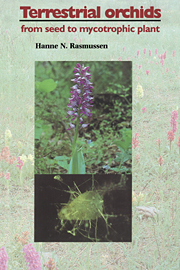Book contents
- Frontmatter
- Contents
- Acknowledgements
- Introduction
- 1 Properties of ‘dust’ seeds
- 2 Seed development
- 3 Seed survival
- 4 Requirements for germination
- 5 Fungi
- 6 Germination processes
- 7 Underground organs
- 8 Orchid mycorrhiza
- 9 Abiotic factors in growth and development
- 10 Life history and phenology
- 11 Propagation
- 12 Effects of orchid mycorrhiza
- 13 Descriptions of genera
- Appendix A Nutrient substrates mentioned in the text
- Appendix B Names and synonyms
- References
- Index
10 - Life history and phenology
Published online by Cambridge University Press: 13 October 2009
- Frontmatter
- Contents
- Acknowledgements
- Introduction
- 1 Properties of ‘dust’ seeds
- 2 Seed development
- 3 Seed survival
- 4 Requirements for germination
- 5 Fungi
- 6 Germination processes
- 7 Underground organs
- 8 Orchid mycorrhiza
- 9 Abiotic factors in growth and development
- 10 Life history and phenology
- 11 Propagation
- 12 Effects of orchid mycorrhiza
- 13 Descriptions of genera
- Appendix A Nutrient substrates mentioned in the text
- Appendix B Names and synonyms
- References
- Index
Summary
Since the young seedling of terrestrial orchids lives underground, the early life history is largely unknown. Some investigators have painstakingly dup up seedlings and underground structures around the year and endeavoured to deduce the developmental process from this material (Fuchs & Ziegenspeck 1924a, b, 1926a, b, 1927a–c). This is usually the only source of information that we have as regards the life history since many species has never been grown from seed to the adult stage in culture or their life history has not been described when cultured plants were available.
Both excavation of plants in natural populations and observation of cultured specimens have their limitations as methods of investigating the life history. Unless the same individuals are repeatedly dug up and carefully replanted this method gives information only on the sequence of organogenesis and a rough seasonal timetable. Construction of an absolute timetable requires that there is a close correspondence between size and age, but this assumption is unrealistic, since cultivated seedlings of many species show considerable individual variation under uniform culture conditions. Estimates of the duration of seedling stages that have been made on the basis of excavations, particularly by Fuchs & Ziegenspeck (1922–7), have been justly criticized for being exaggerated, but it is mainly the most extreme estimates such as for the underground phase of Orchis ustulata that have been singled out (Summerhayes, 1951) and been met with scepticism. Most of the estimates made by Fuchs & Ziegenspeck do not fall wide of the mark if they are compared with those now emerging from population studies, as can be judged from Table 10.1.
- Type
- Chapter
- Information
- Terrestrial OrchidsFrom Seed to Mycotrophic Plant, pp. 197 - 218Publisher: Cambridge University PressPrint publication year: 1995



